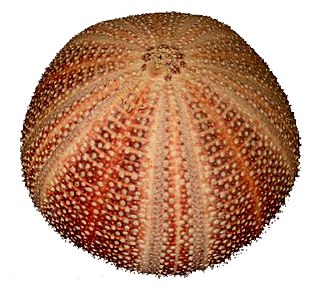 W
WIn zoology, an ambulacrum is an elongated area of the shell of an echinoderm in which a row of tube feet are arranged. It is pluralized as ambulacra. The area on the shell between ambulacra is known as an interambulacrum.
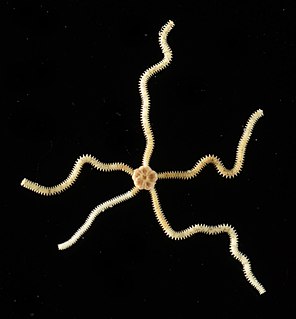 W
WAmphiodia is a genus of brittle stars belonging to the family Amphiuridae.
 W
WAmphipholis is a large genus of brittle stars (Ophiuroidea) found in oceans worldwide from tropics to Arctic and Antarctic regions. Some species have been used to study echinoderm development and bioluminescence.
 W
WAmphiura is a large genus of brittle stars (Ophiuroidea) found in oceans worldwide from tropics to Arctic and Antarctic regions.
 W
WAmphiura callida is a species of brittle star belonging to the family Amphiuridae. It is only known from the continental shelf off the coast of Cabo Frio, southeastern Brazil.
 W
WAmphiuridae are a large family of brittle stars of the suborder Gnathophiurina. Some species are used to study echinoderm development and bioluminescence.
 W
WAstroboa is a genus of basket stars in the class Ophiuroidea.
 W
WAstroboa nuda is a type of basket star from Gorgonocephalidae family. Its large arms are highly branched. It inhabits reef slopes exposed to current in diverse places such as the Red Sea and New Caledonia. During the day it coils into a tight ball. At night it spreads arms to form a basket to feed on plankton. They are part of the class Ophiuroidea, which is the largest class of echinoderms. The name Ophiuroidea comes from the roots, ophis, meaning snake and oura, which means tail, referring to the thin, spiraling shape of the basket stars’ arms.
 W
WAstrobrachion adhaerens is a basket star in the Euryalidae family. Along with Astrobrachion constrictum, it is one of only two species in the genus Astrobrachion. Both species live in association with black corals in moderately deep water. It is endemic to the west, north and east coasts of Australia, the Kermadec Islands and Lord Howe Island.
 W
WBasket stars, sometimes referred to as a "Shetland Argus", are a taxon of brittle stars. They are treated as a suborder Euryalina or order Euryalida. Many of them have characteristic repeatedly branched arms. They generally live in deep sea habitats. However, they have been observed near 15 m or less in Plettenberg Bay, South Africa. In the wild they may live up to 35 years. They weigh up to 5 kilograms (11 lb). Like other echinoderms, basket stars lack blood and achieve gas exchange via their water vascular system.
 W
WA bipinnaria is the first stage in the larval development of most starfish, and is usually followed by a brachiolaria stage. Movement and feeding is accomplished by the bands of cilia. Starfish that brood their young generally lack a bipinnaria stage, with the eggs developing directly into miniature adults
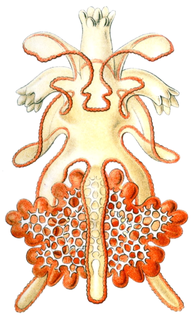 W
WA brachiolaria is the second stage of larval development in many starfishes it follows the bipinnaria. Brachiolaria have bilateral symmetry, unlike the adult starfish, which have a pentaradial symmetry. Starfish of the order Paxillosida have no brachiolaria stage, with the bipinnaria developing directly into an adult.
 W
WCrinozoa is a subphylum of mostly sessile echinoderms, of which the crinoids, or sea lilies, are the only extant members. Crinozoans have an extremely extensive fossil history, which may or may not extend into the Precambrian.
 W
WCuvierian tubules are clusters of fine tubes located at the base of the respiratory tree in some sea cucumbers in the genera Bohadschia, Holothuria and Pearsonothuria, all of which are included in the family Holothuriidae. The tubules can be discharged through the anus when the sea cucumber is stressed. They lengthen when they come into contact with seawater and become adhesive when they encounter objects so that they function as a defence against potential predators. They are named after the French zoologist Georges Cuvier, who first described them.
 W
WDipleurula is a hypothetical larva of the Echinoderms. It represents the type of basis of all larva forms of the Eleutherozoa, to which the sea-stars, sea-hedgehog, sea-rollers and sand stars belong. The Dipleurula is a bilaterally symmetrical, ciliated echinoderm larva.
 W
WEchinozoa is a subphylum of free-living echinoderms in which the body is or originally was a modified globe with meridional symmetry. Echinozoans lack arms, brachioles, or other appendages, and do not at any time exhibit pinnate structure. Their two extant classes are the sea urchins and the sea cucumbers.
 W
WEleutherozoa is a proposed subphylum of echinoderms. They are mobile animals with the mouth directed towards the substrate. They usually have a madreporite, tube feet, and moveable spines of some sort, and some have Tiedemann's bodies on the ring canal. All living echinoderms except Crinoidea belong here.
 W
WThe Gnathophiurina are a group of Ophiuroidea mostly treated as suborder.
 W
WGorgonocephalidae is a family of basket stars. They have characteristic many-branched arms.
 W
WGorgonocephalus is a genus of marine basket stars in the class Ophiuroidea. Members of this genus are found in coldwater environments including the Arctic, the Antarctic, and deep-sea habitats. The scientific name comes from the Greek, gorgós meaning "dreaded" and -cephalus meaning "head", and refers to the similarity between these echinoids and the Gorgon's head from Greek myth with its coiled serpents for hair. The Greek mythological hero Perseus beheaded the Gorgon Medusa; when Perseus later dropped Medusa's head on the beach, her petrifying glance turned the nearby seaweed to stone, creating the first coral.
 W
WGorgonocephalus arcticus is a species of basket star in the class Ophiuroidea. The genus name comes from the Greek, gorgós meaning "dreaded" and cephalus meaning "head", and refers to the similarity between these echinoids and the Gorgon's head from Greek myth with its coiled serpents for hair. This species is also able to live non parasitically on the exterior of other sessile animals while it continues to grow. G. arcticus have been observed living on the exterior of Boltenia ovifera, a species of tunicates found in a similar range of the Arctic to Cape Cod. This species is found in varying depths in the water column, from as shallow as the sublittoral zone to a maximum depth of 1500 m. Their feeding mechanism has been extensively studied in the wild and in captivity.
 W
WThe madreporite is a light colored calcareous opening used to filter water into the water vascular system of echinoderms. It acts like a pressure-equalizing valve. It is visible as a small red or yellow button-like structure, looking like a small wart, on the aboral surface of the central disk of a sea star or sea urchin. Close up, it is visibly structured, resembling a "madrepore" colony. From this, it derives its name.
 W
WOphiactidae are a family of brittle stars.
 W
WOphiocoma is a genus of brittle stars belonging to the family Ophiocomidae.
 W
WOphiocoma scolopendrina is a species of brittle star belonging to the family Ophiocomidae.
 W
WOphiocomidae are a family of brittle stars of the suborder Ophiurina.
 W
WOphiocomina is a genus of brittle star belonging to the family Ophiocomidae.
 W
WOphiodermatidae are a family of brittle stars in the suborder Ophiurina.
 W
WOphiolepididae are a family of brittle stars of the suborder Ophiurina. It includes both deep-sea and shallow-water species.
 W
WOphionereididae are a family of brittle stars.
 W
WOphionereis schayeri, Schayer's brittle star, is a brittle star in the family Ophionereididae.
 W
WOphiopetra is a genus of prehistoric brittle stars. It lived in lagoons in Solnhofen Plattenkalk Formation. It has only one known species, Ophioptera lithographica.
 W
WOphiopholis is a genus of brittle stars (Ophiuroidea) found in oceans worldwide from tropics to temperate regions.
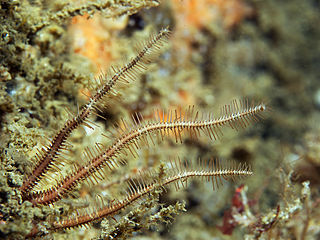 W
WOphiopsila is a genus of brittle star belonging to the family Ophiocomidae. Many species are bioluminescent.
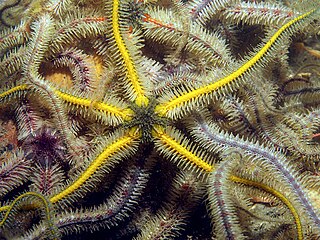 W
WOphiothrix is a large genus of brittle stars (Ophiuroidea) found in oceans worldwide from tropics to Arctic and Antarctic regions.
 W
WOphiotrichidae are a family of ophiurid brittle stars within the infraorder Gnathophiurina.
 W
WThe Ophiurida are an order of echinoderms within the class Ophiuroidea. It includes the vast majority of living brittle stars.
 W
WOphiuridae are a large family of brittle stars of the suborder Ophiurina.
 W
WOphiurina are a suborder of brittle stars containing the majority of living brittle star species.
 W
WA pedicellaria is a small wrench- or claw-shaped appendage with movable jaws, called valves, commonly found on echinoderms, particularly in sea stars and sea urchins. Each pedicellaria is an effector organ with its own set of muscles, neuropils, and sensory receptors and is therefore capable of reflex responses to the environment. Pedicellariae are poorly understood but in some taxa, they are thought to keep the body surface clear of algae, encrusting organisms, and other debris in conjunction with the ciliated epidermis present in all echinoderms.
 W
WThe Phrynophiurida are an order of brittle stars containing the basket stars.
 W
WStelleroidea is a superclass of marine echinoderms including three classes:Asteroidea: true sea stars Ophiuroidea: brittle stars and basket stars Somasteroidea : ancestral stelleroids